Subaru WRX (2021 year). Manual in english — page 23
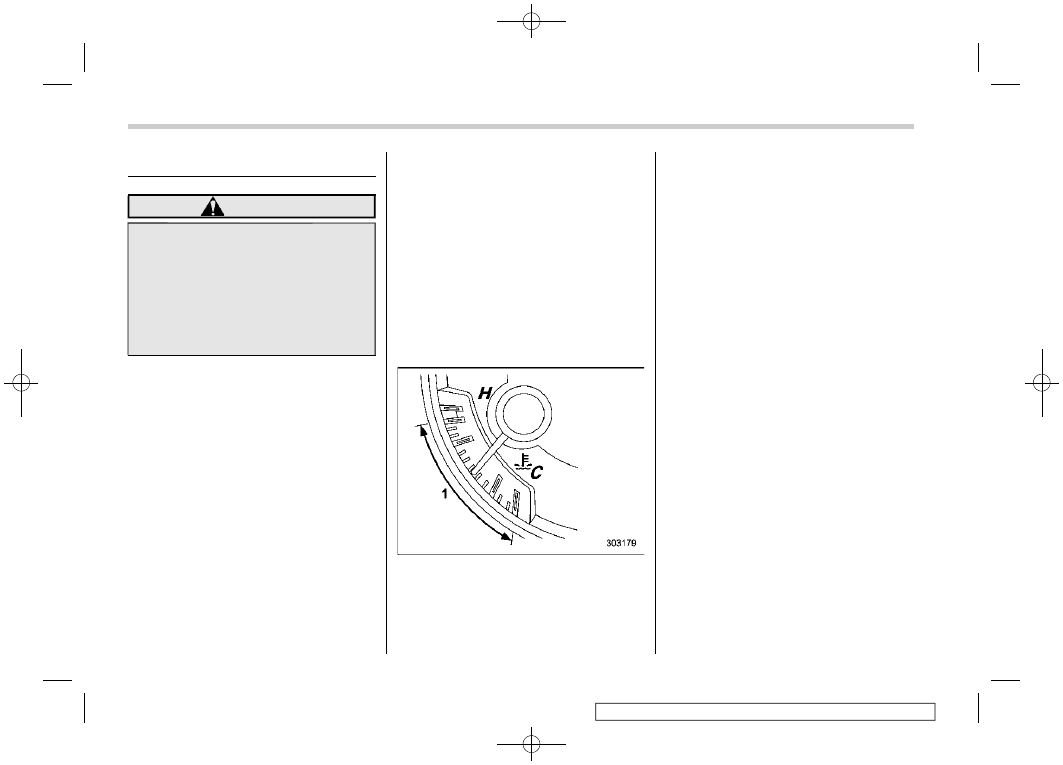
(366,1)
Engine overheating
WARNING
Never remove the radiator cap until
the engine has been shut off and has
fully cooled down. When the engine
is hot, the coolant is under pressure.
Removing the cap while the engine
is still hot could release a spray of
boiling hot coolant, which could
burn you very seriously.
If the engine overheats, safely pull off the
road and stop the vehicle in a safe
location.
&
If steam is coming from the
engine compartment
.
Turn off the engine and get everyone
away from the vehicle until it cools down.
.
Contact an authorized SUBARU deal-
er.
&
If no steam is coming from the
engine compartment
1. Keep the engine running at idling
speed.
2. Open the engine hood to ventilate the
engine compartment. Refer to “Engine
hood”
Confirm that the cooling fan is turning. If
the fan is not turning, immediately turn off
the engine and contact an authorized
SUBARU dealer for repair.
3. After the engine coolant temperature
has dropped, turn off the engine.
Temperature gauge
1)
Normal operating range
If temperature gauge stays in the over-
heated zone, turn off the engine. Refer to
“Temperature gauge”
4. After the engine has fully cooled down,
check the coolant level in the reserve tank.
If the coolant level is below the “LOW”
mark, add coolant up to the “FULL” mark.
NOTE
For details about how to check the
coolant level or how to add coolant,
refer to “Engine coolant”
5. If there is no coolant in the reserve
tank, add coolant to the reserve tank. Then
remove the radiator cap and fill the radiator
with coolant.
If you remove the radiator cap from a hot
radiator, first wrap a thick cloth around the
radiator cap, then turn the cap counter-
clockwise slowly without pressing down
until it stops. Release the pressure from
the radiator. After the pressure has been
fully released, remove the cap by pressing
down and turning it.
In case of emergency/Engine overheating
9-12
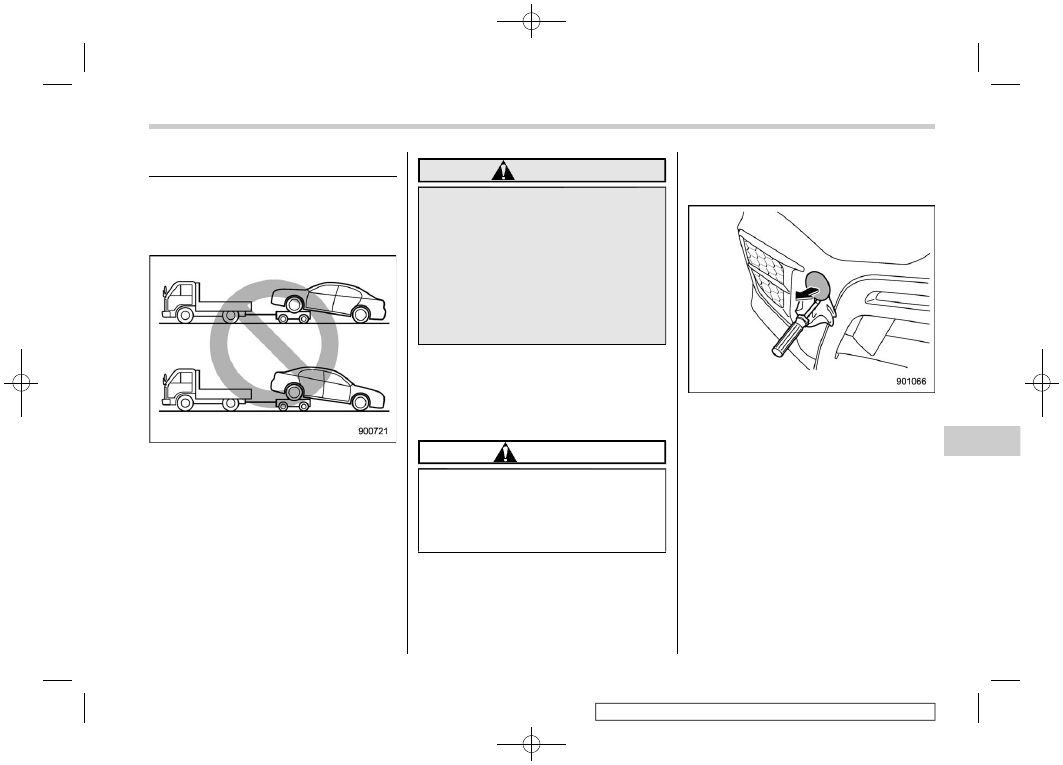
(367,1)
Towing
If towing is necessary, it is best done by
your SUBARU dealer or a commercial
towing service. Observe the following
procedures for safety.
WARNING
Never tow AWD models (both CVT
and MT models) with the front
wheels raised off the ground while
the rear wheels are on the ground, or
with the rear wheels raised off the
ground while the front wheels are on
the ground. This will cause the
vehicle to spin away due to the
operation or deterioration of the
center differential.
&
Towing and tie-down hooks/
holes
The towing hook should be used only in an
emergency.
CAUTION
Use only the specified towing hook
and tie-down hooks/holes. Never
use suspension parts or other parts
of the body for towing or tie-down
purposes.
Front towing hook:
1. Take the towing hook, screwdriver and
wheel nut wrench out of the tool bucket.
2. Cover the tip of a flat-head screwdriver
with vinyl tape or cloth so that it will not
scratch the bumper. Insert the flat-head
screwdriver into the cutout of the cover and
pry open the cover.
– CONTINUED –
In case of emergency/Towing
9-13
9

(368,1)
3. Screw the towing hook into the thread
hole until its thread can no longer be seen.
4. Tighten the towing hook securely using
the wheel nut wrench.
After towing, remove the towing hook from
the vehicle and stow it in the tool bucket.
Fit the towing hook cover on the bumper.
WARNING
.
Do not use the towing hook
except when towing your vehicle.
.
Be sure to remove the towing
hook after towing. Leaving the
towing hook mounted on the
vehicle could interfere with prop-
er operation of the SRS airbag
system in a frontal collision.
CAUTION
To prevent deformation to the bum-
per and the towing hook, do not
apply an excessive load to the tow-
ing hook.
Rear towing hook:
1. Take the towing hook, screwdriver and
wheel nut wrench out of the tool bucket.
2. Pry off the cover on the rear bumper
using a screwdriver, and you will find a
threaded hole for attaching the towing
hook.
In case of emergency/Towing
9-14
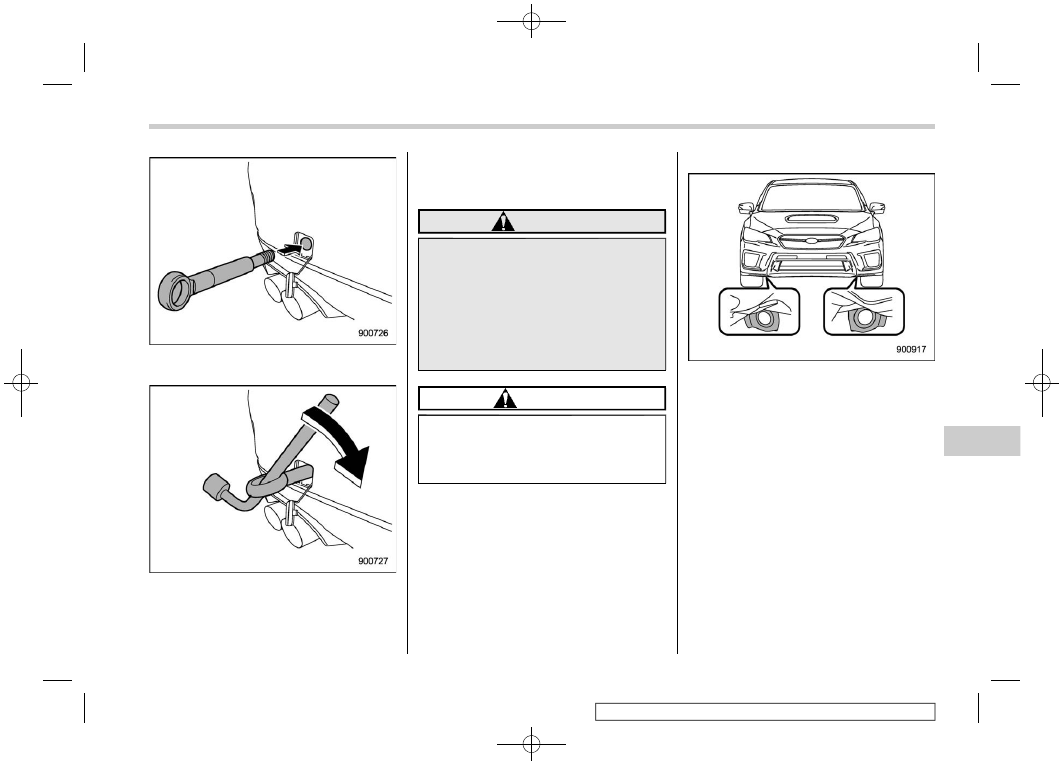
(369,1)
3. Screw the towing hook into the thread
hole until its thread can no longer be seen.
4. Tighten the towing hook securely using
the wheel nut wrench.
After towing, remove the towing hook from
the vehicle and stow it in the tool bucket.
Fit the towing hook cover on the bumper.
WARNING
Do not use the towing hook except
when towing your vehicle.
Be sure to remove the towing hook
after towing. Leaving the towing
hook mounted on the vehicle could
interfere with proper operation of
the fuel pump shut off function when
the vehicle is struck from behind.
CAUTION
To prevent deformation to the bum-
per and the towing hook, do not
apply an excessive load to the tow-
ing hook.
Front tie-down hooks:
The front tie-down hooks are located
between each of the front tires and the
front bumper.
– CONTINUED –
In case of emergency/Towing
9-15
9
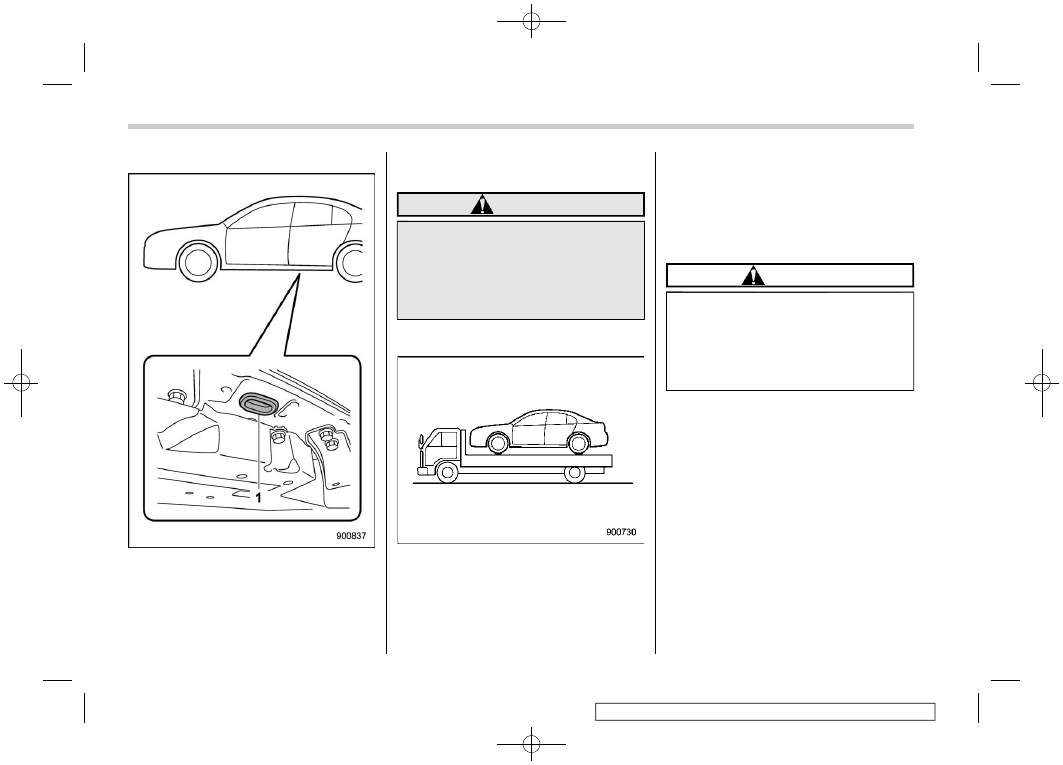
(370,1)
Rear tie-down holes:
1)
Rear tie-down hole
The rear tie-down holes are located near
each of the jack-up reinforcements.
There is a plug in each rear tie-down hole.
To use the rear tie-down holes, remove the
plugs. After using the rear tie-down holes,
return the plugs to their original places.
WARNING
Use the rear tie-down holes only for
downward anchoring. If they are
used to anchor the vehicle in any
other direction, cables may slip out
of the holes, possibly causing a
dangerous situation.
&
Using a flat-bed truck
This is the best way to transport your
vehicle. Use the following procedures to
ensure safe transportation.
1. Shift the select lever into the “P”
position for CVT models. Shift the shift
lever into the “1st” position for MT models.
2. Apply the parking brake firmly.
3. Secure the vehicle onto the carrier
properly with safety chains. Each safety
chain should be equally tightened and care
must be taken not to pull the chains so
tightly that the suspension bottoms out.
CAUTION
If your vehicle has a front under-
spoiler and rear underspoiler (both
optional), be careful not to scrape
them when placing the vehicle on
the carrier and when removing the
vehicle from the carrier.
In case of emergency/Towing
9-16

(371,1)
&
Towing with all wheels on the
ground
1. Release the parking brake and put the
transmission in the “N”/neutral position.
2. The ignition switch should be in the
“ON” position while the vehicle is being
towed.
3. Take up slack in the towline slowly to
prevent damage to the vehicle.
WARNING
.
Never turn the ignition switch to
the “LOCK”/“OFF” position while
the vehicle is being towed be-
cause the steering wheel and the
direction of the wheels will be
locked.
.
Remember that the brake booster
and power steering do not func-
tion when the engine is not run-
ning. Because the engine is
turned off, it will take greater
effort to operate the brake pedal
and steering wheel.
CAUTION
.
If transmission failure occurs,
transport your vehicle on a flat-
bed truck.
.
Sometime damaged vehicles can-
not be towed because of their
damaged conditions.
In this case, use a flat-bed truck
for transportation.
.
For CVT models, the traveling
speed must be limited to less
than 20 mph (32 km/h) and the
traveling distance to less than 31
miles (50 km). For greater speeds
and distances, transport your
vehicle on a flat-bed truck.
.
Use a flat-bed truck if there are a
long distance downgrades or
steep slopes. However, do not
apply the brake pedal for a long
time because the engine braking
will not work while towing. Doing
so could overheat the brake.
.
Drive carefully and do not make
an impact on the towing rope by
suddenly starting.
.
Use a specific towing rope for
towing. If wire ropes and metal
chains are needed to be used for
towing, wrap the contact portion
of the bumper with cloth to pro-
tect it from damage.
In case of emergency/Towing
9-17
9
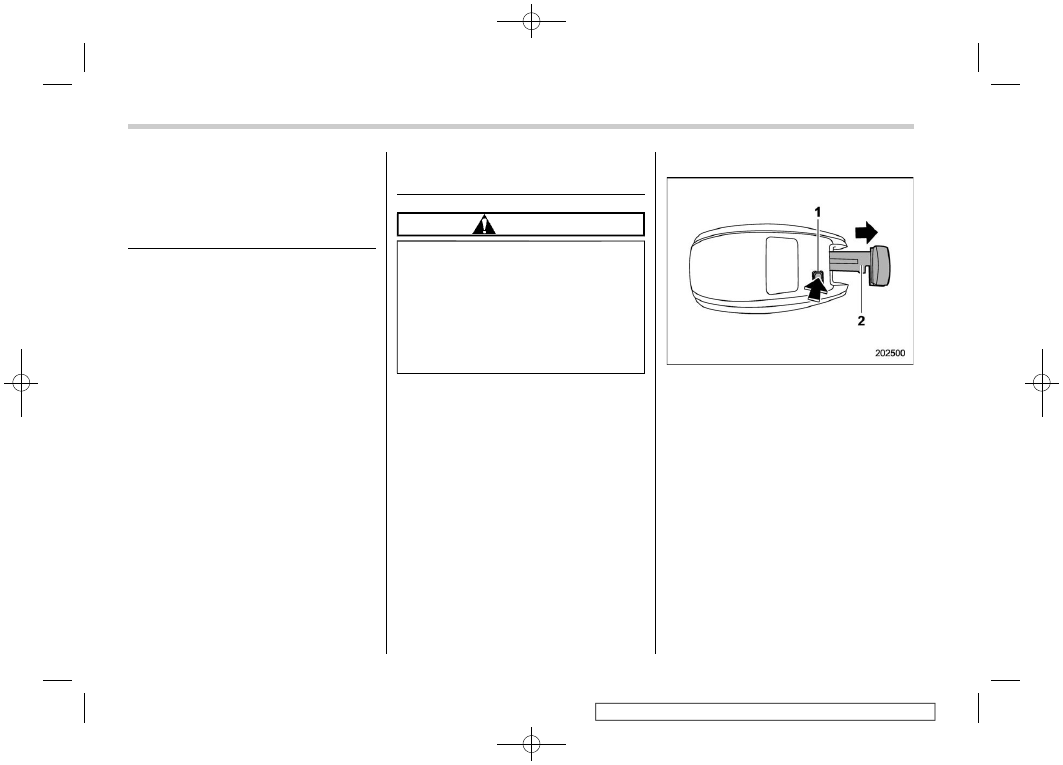
(372,1)
Electronic parking brake – if
the electronic parking brake
cannot be released (models
with electronic parking brake
system)
Contact your SUBARU dealer and have
your SUBARU dealer release the electro-
nic parking brake.
Access key fob – if access key
fob does not operate properly
CAUTION
Keep metallic objects, magnetic
sources and signal transmitters
away from the area between the
access key fob and the push-button
ignition switch. They may interfere
with the communication between
the access key fob and the push-
button ignition switch.
The following functions may be inoperable
because of strong radio signals in the
surrounding area or a low battery condition
of the access key fob.
.
Locking/unlocking doors
.
Switching power status
.
Starting the engine
In such cases, perform the following
procedure. When the battery of the access
key fob is discharged, replace it with a new
one. Refer to “Replacing battery of access
key fob”
&
Locking and unlocking
1)
Release button
2)
Emergency key
While pressing the release button of the
access key fob, take out the emergency
key.
Lock or unlock the driver’s door with the
emergency key.
NOTE
After locking or unlocking, be sure to
reinsert the emergency key into the
access key fob.
In case of emergency/Electronic parking brake – if the electronic parking brake cannot be released (models with electronic parking
brake system)
9-18
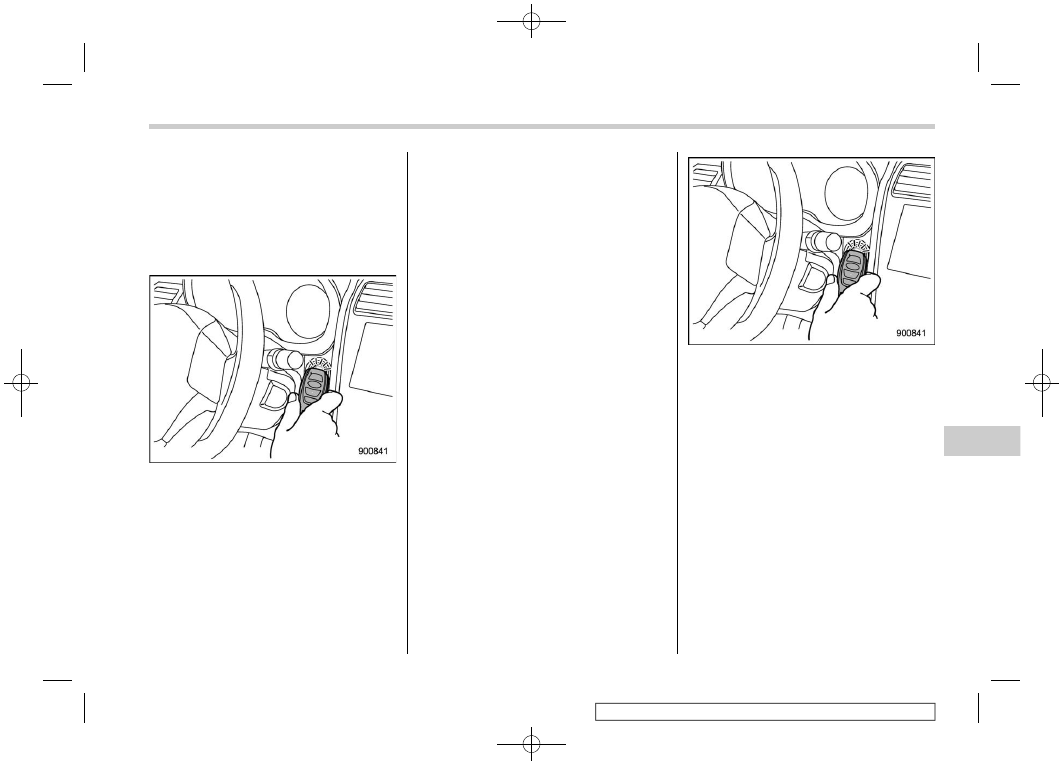
(373,1)
&
Switching power status
1. Apply the parking brake.
2. Shift the shift lever into neutral (MT
models) or the select lever into the “P”
position (CVT models).
3. Depress the clutch pedal (MT models)
or brake pedal (CVT models).
4. Hold the access key fob with the
buttons facing you, and touch the push-
button ignition switch with it.
When the communication between the
access key fob and the vehicle is com-
pleted, a chime (ding) will sound. At the
same time, the status of the push-button
ignition switch changes to either of the
following.
.
When the keyless access with push-
button start system is deactivated:
“ACC”
.
Under other conditions: “ON”
5. When the keyless access with push-
button start system is deactivated, press
the push-button ignition switch with the
clutch pedal (MT models) or brake pedal
(CVT models) released. The status of the
push-button ignition switch then changes
to “ON”.
NOTE
If the power does not switch even
though the above procedure was fol-
lowed precisely, contact your SUBARU
dealer.
&
Starting engine
1. Apply the parking brake.
2. Shift the shift lever into neutral (MT
models) or the select lever into the “P”
position (CVT models).
3. Depress the brake pedal (all models).
4. Depress the clutch pedal (MT models).
5. Hold the access key fob with the
buttons facing you, and touch the push-
button ignition switch with it.
When the communication between the
access key fob and the vehicle is com-
pleted, a chime (ding) will sound. At the
same time, the push-button ignition switch
turns to the “ACC” or “ON” position.
6. Within 5 seconds after the push-button
ignition switch turns to the “ACC” or “ON”
position, while depressing the brake pedal
(all models) and the clutch pedal (MT
models), press the push-button ignition
switch.
– CONTINUED –
In case of emergency/Access key fob – if access key fob does not operate properly
9-19
9
(374,1)
NOTE
If the engine does not start even though
the above procedure was followed
precisely, contact your SUBARU dealer.
Moonroof (if equipped) – if the
moonroof does not close
If the moonroof does not close, we
recommend that you have the system
checked by a SUBARU dealer.
If your vehicle is involved in
an accident
CAUTION
If your vehicle is involved in an
accident, be sure to inspect the
ground under the vehicle before
restarting the engine. If you find that
fuel has leaked on the ground, do
not try to restart the engine. The fuel
system has been damaged and is in
need of repair. Immediately contact
the nearest automotive service facil-
ity. We recommend that you consult
your SUBARU dealer.
Your vehicle has a fuel pump shut off
system. To minimize the risk of fire due to
fuel leakage when your vehicle is subject
to impact from an accident or another
factor, the system stops supplying fuel.
However, depending on the impact condi-
tions at the time of collision, the fuel pump
shut-off system may not operate.
Perform the following procedures to restart
the engine after the system is activated.
In case of emergency/Moonroof – if the moonroof does not close
9-20
(375,1)
Models without “keyless access with
push-button start system”:
1. Turn the ignition switch to the “LOCK”
or “ACC” position.
2. Restart the engine.
Models with “keyless access with
push-button start system”:
1. Turn the push-button ignition switch to
the “ACC” or “OFF” position.
2. Restart the engine.
In case of emergency/If your vehicle is involved in an accident
9-21
9
(377,1)
Exterior care. . . . . . . . . . . . . . .. 10-2
Washing . . . . . . . . . . . . . . . ... 10-2
Waxing and polishing. . . . . . . . . . . 10-3
Cleaning alloy wheels . . . . . . . . . . ... 10-3
Corrosion protection . . . . . . . . . . . 10-4
Most common causes of corrosion . . . . . ... 10-4
To help prevent corrosion . . . . . . . . . . 10-4
Cleaning the interior. . . . . . . . . . . . 10-5
Seat fabric . . . . . . . . . . . . . . . 10-5
Leather Seat Materials . . . . . . . . . . .. 10-5
Synthetic leather upholstery . . . . . . . . . 10-5
Climate control panel, audio panel, instrument
panel, console panel, and switches. . . . . 10-6
Monitor. . . . . . . . . . . . . . . . . 10-6
Appearance care
10
(378,1)
Exterior care
&
Washing
CAUTION
.
When washing the vehicle, the
brakes may get wet. As a result,
the brake stopping distance will
be longer. To dry the brakes, drive
the vehicle at a safe speed while
lightly depressing the brake ped-
al to heat up the brakes.
.
Do not wash the engine compart-
ment and area adjacent to it. If
water enters the engine air intake
or electrical parts, it will cause
engine trouble or a malfunction
of electrical equipment.
.
When washing the inner fenders,
underbody, bumpers and pro-
truding objects such as exhaust
pipes and exhaust finishers, be
careful to prevent injuries from
contacting sharp ends.
.
Do not use any organic solvents
when washing the surface of the
bulb assembly cover. However, if
a detergent with organic solvents
is used to wash the cover sur-
face, completely rinse off the
detergent with water. Otherwise,
the cover surface may be da-
maged.
NOTE
When having your vehicle washed in an
automatic car wash, make sure before-
hand that the car wash is of suitable
type.
The best way to preserve your vehicle’s
beauty is frequent washing. Wash the
vehicle at least once a month to avoid
contamination by road grime.
Wash dirt off with a wet sponge and plenty
of lukewarm or cold water. Do not wash the
vehicle with hot water and in direct sun-
light.
Salt, chemicals, insects, tar, soot, tree sap,
and bird droppings should be washed off
by using a light detergent, as required. If
you use a light detergent, make certain
that it is a neutral detergent. Do not use
strong soap or chemical detergents. All
cleaning agents should be promptly rinsed
off the surface and not allowed to dry there.
Rinse the vehicle thoroughly with plenty of
lukewarm water. Wipe the remaining water
off with a chamois or soft cloth. Wear
rubber gloves and use a hand brush when
washing down underbody, inner fenders
and suspension to effectively remove mud
and dirt off.
!
Washing the underbody
Chemicals, salts and gravel used for
deicing road surfaces are extremely cor-
rosive, accelerating the corrosion of un-
derbody components, such as the exhaust
system, fuel and brake lines, brake cables,
floor pan and fenders, and suspension.
Thoroughly flush the underbody and inside
of the fenders with lukewarm or cold water
at frequent intervals to reduce the harmful
effects of such agents.
Mud and sand adhering to the underbody
components may accelerate their corro-
sion.
After driving off-road or on muddy or sandy
roads, wash the mud and sand off the
underbody. Carefully flush the suspension
and axle parts, as they are particularly
prone to mud and sand buildup. Do not use
a sharp-edged tool to remove caked mud.
CAUTION
.
Be careful not to damage brake
hoses, sensor harnesses, and
other parts when washing sus-
pension components.
.
Be careful not to flush the engine
bottom for a long time. It may
cause damage of some electrical
Appearance care/Exterior care
10-2
(379,1)
parts.
!
Using a warm water washer
.
Keep a good distance of 12 in (30 cm)
or more between the washer nozzle and
the vehicle.
.
Do not wash the same area continu-
ously.
.
If a stain will not come out easily, wash
by hand. Some warm water washers are of
the high temperature, high pressure type,
and they can damage or deform the resin
parts such as moldings, or cause water to
leak into the vehicle.
&
Waxing and polishing
Always wash and dry the vehicle before
waxing and polishing.
Use a good quality polish and wax and
apply them according to the manufac-
turer’s instructions. Wax or polish when
the painted surface is cool.
Be sure to polish and wax the chrome trim,
as well as the painted surfaces. Loss of
wax on a painted surface leads to loss of
the original luster and also quickens the
deterioration of the surface. It is recom-
mended that a coat of wax be applied at
least once a month, or whenever the
surface no longer repels water.
If the appearance of the paint has dimin-
ished to the point where the luster or tone
cannot be restored, lightly polish the sur-
face with a fine-grained compound. Never
polish just the affected area, but include
the surrounding area as well. Always
polish in only one direction. A No. 2000
grain compound is recommended. Never
use a coarse-grained compound. Coarse-
grained compounds have a smaller grain-
size number and could damage the paint.
After polishing with a compound, coat with
wax to restore the original luster. Frequent
polishing with a compound or an incorrect
polishing technique will result in removing
the paint layer and exposing the under-
coat. When in doubt, it is always best to
contact your SUBARU dealer or an auto
paint specialist.
CAUTION
Do not use any agents with organic
solvents on the surface of the bulb
assembly cover. However, if a polish
or wax with organic solvents is
applied to the cover surface, com-
pletely wipe off the polish or wax.
Otherwise, the cover surface may be
damaged.
NOTE
Be careful not to block the windshield
washer nozzles with wax when waxing
the vehicle.
&
Cleaning alloy wheels
.
Promptly wipe the alloy wheels clean of
any kind of grime or agent. If dirt is left on
too long, it may be difficult to clean off.
.
Do not use soap containing grit to clean
the wheels. Be sure to use a neutral
cleaning agent, and later rinse thoroughly
with water. Do not clean the wheels with a
stiff brush or expose them to a high-speed
washing device.
.
Clean the vehicle (including the alloy
wheels) with water as soon as possible
when it has been splashed with sea water,
exposed to sea breezes, or driven on
roads treated with salt or other agents.
Appearance care/Exterior care
10-3
10
(380,1)
Corrosion protection
Your SUBARU has been designed and
built to resist corrosion. Special materials
and protective finishes have been used on
most parts of the vehicle to help maintain
fine appearance, strength, and reliable
operation.
&
Most common causes of cor-
rosion
The most common causes of corrosion
are:
.
The accumulation of moisture retaining
dirt and debris in body panel sections,
cavities, and other areas.
.
Damage to paint and other protective
coatings caused by gravel and stone chips
or minor accidents.
Corrosion is accelerated on the vehicle
when:
.
It is exposed to road salt or dust control
chemicals, or used in coastal areas where
there is more salt in the air, or in areas
where there is considerable industrial
pollution.
.
It is driven in areas of high humidity,
especially when temperatures range just
above freezing.
.
Dampness in certain parts of the
vehicle remains for a long time, even
though other parts of the vehicle may be
dry.
.
High temperatures will cause corrosion
to parts of the vehicle which cannot dry
quickly due to lack of proper ventilation.
&
To help prevent corrosion
Wash the vehicle regularly to prevent
corrosion of the body and suspension
components. Also, wash the vehicle
promptly after driving on any of the
following surfaces.
.
Roads that have been salted to prevent
them from freezing in winter
.
Mud, sand, or gravel
.
Coastal roads
After the winter has ended, it is recom-
mended that the underbody be given a
very thorough washing.
Before the beginning of winter, check the
condition of underbody components, such
as the exhaust system, fuel and brake
lines, brake cables, suspension, steering
system, floor pan, and fenders. If any of
them are found to be rusted, they should
be given an appropriate rust prevention
treatment or should be replaced. Contact
your SUBARU dealer to perform this kind
of maintenance and treatment if you need
assistance.
Repair chips and scratches in the paint as
soon as you find them.
Check the interior of the vehicle for water
and dirt accumulation under the floor mats
because that could cause corrosion. Oc-
casionally check under the mats to make
sure the area is dry.
Keep your garage dry. Do not park your
vehicle in a damp, poorly ventilated gar-
age. In such a garage, corrosion can be
caused by dampness. If you wash the
vehicle in the garage or put the vehicle into
the garage when wet or covered with
snow, that can cause dampness.
If your vehicle is operated in cold weather
and/or in areas where road salts and other
corrosive materials are used, the door
hinges and locks, and hood latch should
be inspected and lubricated periodically.
Appearance care/Corrosion protection
10-4
(381,1)
Cleaning the interior
Use a soft, damp cloth to clean the climate
control panel, audio equipment, instru-
ment panel, center console, combination
meter panel, and switches. (Do not use
organic solvents.)
&
Seat fabric
Remove loose dirt, dust or debris with a
vacuum cleaner. If the dirt is caked on the
fabric or hard to remove with a vacuum
cleaner, use a soft brush then vacuum it.
Wipe the fabric surface with a tightly wrung
cloth and dry the seat fabric thoroughly. If
the fabric is still dirty, wipe using a solution
of mild soap and lukewarm water then dry
thoroughly.
If the stain does not come out, try a
commercially-available fabric cleaner.
Use the cleaner on a hidden place and
make sure it does not affect the fabric
adversely. Use the cleaner according to its
instructions.
CAUTION
When cleaning the seat, do not use
benzine, paint thinner, or any similar
materials. Doing so could damage
the surface and cause the color to
deteriorate.
&
Leather Seat Materials
The leather used by SUBARU is a high
quality natural product which will retain its
distinctive appearance and feel for many
years with proper care.
Allowing dust or road dirt to build up on the
surface can cause leather to become
brittle and wear prematurely. To maintain
its resiliency, leather should be cleaned
monthly or whenever it becomes soiled.
Before cleaning leather upholstery, va-
cuum it to remove dust. Use a soft and
lint-free cloth dampened with lukewarm
water and mild soap, taking care not to
soak the leather or allow water to pene-
trate the stitched seams. Use a gentle
circular motion while cleaning the leather -
do not rub or apply extreme pressure.
Wipe the leather again with another clean,
slightly damp cloth to remove soap residue
and dry with a soft cloth.
Minor surface blemishes or difficult dirt
spots may be treated with a commercial
leather spray. Never use alcohol, cleaning
solvents, leather oils, varnishes or
polishes on your leather as it will dry out
the leather finish.
If your SUBARU is to be parked for a long
time in bright sunlight, it is recommended
that the seats and headrests be covered,
or the windows shaded, to prevent fading
or shrinkage.
You will discover that each leather seat
section will develop soft folds or wrinkles,
which is characteristic of genuine leather.
&
Synthetic leather upholstery
The synthetic leather material used on the
SUBARU may be cleaned using mild soap
or detergent and water, after first vacuum-
ing or brushing away loose dirt. Allow the
soap to soak in for a few minutes and wipe
off with a clean, damp cloth. Commercial
foam-type cleaners suitable for synthetic
leather materials may be used when
necessary.
CAUTION
Strong cleaning agents such as
solvents, paint thinners, window
cleaner or fuel must never be used
on leather or synthetic interior ma-
terials. Doing so could damage the
surface and cause the color to
deteriorate.
– CONTINUED –
Appearance care/Cleaning the interior
10-5
10
(382,1)
&
Climate control panel, audio
panel, instrument panel, con-
sole panel, and switches
Use a soft, damp cloth to clean the climate
control panel, audio equipment, instru-
ment panel, center console, combination
meter panel, and switches.
CAUTION
.
Do not use organic solvents such
as paint thinners or fuel, or
strong cleaning agents that con-
tain those solvents. Doing so
could damage the surface and
cause the color to deteriorate.
.
Do not use chemical solvents that
contain silicone on the vehicle
audio system, electrical compo-
nents of the air-conditioner or
any switches. If silicone adheres
to these parts, it may cause
damage to electrical compo-
nents.
&
Monitor
To clean the audio/navigation/multi-func-
tion display monitor, wipe it with a silicone
cloth or with a soft cloth. If the monitor is
extremely dirty, clean it with a soft cloth
moistened with neutral detergent then
carefully wipe off any remaining detergent.
CAUTION
.
Do not spray neutral detergent
directly onto the monitor. Doing
so could damage the monitor’s
components.
.
Do not wipe the monitor with a
hard cloth. Doing so could
scratch the monitor.
.
Do not use cleaning fluid that
contains thinner, fuel, or any
other volatile substance. Such
cleaning fluid could erase the
lettering on the switches at the
bottom of the monitor.
Appearance care/Cleaning the interior
10-6

Нет комментариевНе стесняйтесь поделиться с нами вашим ценным мнением.
Текст